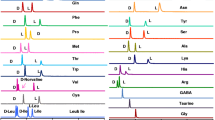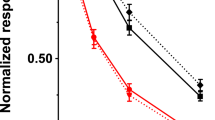Abstract
Using a column-switching HPLC system combining a micro-ODS column and a chiral column, the amounts of d-proline (d-Pro) have been determined in 18 tissues, plasma and urine of mice. To avoid the enzymatic degradation of d-amino acids in vivo, a mutant mouse strain lacking d-amino acid oxidase activity (ddY/DAO− mouse) was used. In the brain, relatively large amounts of d-Pro were observed in the anterior pituitary, posterior pituitary and pineal glands. In the peripheral tissues, the amounts of d-Pro were high in the pancreas and kidney. Above all, it is surprising that the ddY/DAO− mice excreted large amounts of d-Pro in their urine (433 nmol/mL, 20 times that of l-Pro). The origin of d-Pro has also been investigated. By comparing germ-free mice and gnotobiotic mice, intestinal bacteria were shown to have no effect on the urinary d-Pro amount. Concerning the dietary origin, a notable amount of d-Pro was still excreted in the urine after starvation for 4 days, suggesting that some of the d-Pro is produced in the mice. Age-dependent changes in the urinary d-Pro amount have also been investigated from the postnatal 1st month up to 12 months, and ddY/DAO− mice were found to excrete large amounts of d-Pro in the urine constantly throughout their lives.

Kenji Hamase is Associate Professor in the Department of Bioanalytical Chemistry, Graduate School of Pharmaceutical Sciences at Kyushu University. His current research interests focus on the development of analytical methods for d-amino acids and the study of their physiological functions and diagnostic values. He received the Japanese Society for Analytical Chemistry Award for Young Scientists in 2003, and the PSJ Award for Young Scientists in 2006.





Similar content being viewed by others
References
Fujii N, Saito T (2004) Chem Rec 4:267–278
Hamase K, Morikawa A, Zaitsu K (2002) J Chromatogr B 781:73–91
Fujii N (2002) Orig Life Evol Biosph 32:103–127
Nishikawa T (2005) Biol Pharm Bull 28:1561–1565
Hashimoto A, Oka T (1997) Prog Neurobiol 52:325–353
Snyder SH, Kim PM (2000) Neurochem Res 25:553–560
Schell MJ, Molliver ME, Snyder SH (1995) Proc Natl Acad Sci USA 92:3948–3952
Furuchi T, Homma H (2005) Biol Pharm Bull 28:1566–1570
Wolosker H, D’Aniello A, Snyder SH (2000) Neuroscience 100:183–189
D’Aniello G, Tolino A, D’Aniello A, Errico F, Fisher GH, Fiore MMD (2000) Endocrinology 141:3862–3870
Takigawa Y, Homma H, Lee JA, Fukushima T, Santa T, Iwatsubo T, Imai K (1998) Biochem Biophys Res Commun 248:641–647
Nagata Y, Masui R, Akino T (1992) Experientia 48:986–988
Armstrong DW, Gasper MP, Lee SH, Ercal N, Zukowski J (1993) Amino Acids 5:299–315
Brückner H, Schieber A (2001) Biomed Chromatogr 15:166–172
Nagata Y, Konno R, Niwa A (1994) Metabolism 43:1153–1157
Kampel D, Kupferschmidt R, Lubec G (1990) In: Lubec G, Rosenthal GA (eds) Amino acids; chemistry biology and medicine. Escom, Leiden, pp 1164–1171
Schieber A, Brückner H, Rupp-Classen M, Specht W, Nowitzki-Grimm S, Classen HG (1997) J Chromatogr B 691:1–12
Cherkin A, Davis JL, Garman MW (1978) Pharmacol Biochem Behav 8:623–625
Pilone MS (2000) Cell Mol Life Sci 57:1732–1747
Konno R, Yasumura Y (1992) Int J Biochem 24:519–524
Hamase K, Inoue T, Morikawa A, Konno R, Zaitsu K (2001) Anal Biochem 298:253–258
Konno R, Yasumura Y (1983) Genetics 103:277–285
Konno R, Yasumura Y (1988) Lab Anim Sci 38:292–295
Konno R, Oowada T, Ozaki A, Iida T, Niwa A, Yasumura Y, Mizutani T (1993) Am J Physiol 265:G699–G703
Hamase K, Konno R, Morikawa A, Zaitsu K (2005) Biol Pharm Bull 28:1578–1584
Corrigan JJ (1969) Science 164:142–149
Konno R, Niwa A, Yasumura Y (1990) Biochem J 268:263–265
Cardinale GJ, Abeles RH (1968) Biochemistry 7:3970–3978
Rudnick G, Abeles RH (1975) Biochemistry 14:4515–4522
D’Aniello A, Fiore MMD, D’Aniello G, Colin FE, Lewis G, Setchell BP (1998) FEBS Lett 436:23–27
Long Z, Homma H, Lee J-A, Fukushima T, Santa T, Iwatsubo T, Yamada R, Imai K (1998) FEBS Lett 434:231–235
Wolosker H, Sheth KN, Takahashi M, Mothet JP, Brady RO Jr, Ferris CD, Snyder SH (1999) Proc Natl Acad Sci USA 96:721–725
Hashimoto A, Oka T, Nishikawa T (1995) Eur J Neurosci 7:1657–1663
Morikawa A, Hamase K, Zaitsu K (2003) Anal Biochem 312:66–72
Hamase K, Homma H, Takigawa Y, Fukushima T, Santa T, Imai K (1997) Biochim Biophys Acta 1334:214–222
Acknowledgements
The authors thank Drs. Mizutani, Ozaki and Oowada, RIKEN, for the collection of urine from the germ-free and gnotobiotic ddY/DAO− mice. This work was supported in part by a Grant-in-Aid for Scientific Research from the Ministry of Education, Culture, Sports, Science and Technology of Japan, Takeda Science Foundation, and Industrial Technology Research Grant Program in ’05 from New Energy and Industrial Technology Development Organization (NEDO) of Japan.
Author information
Authors and Affiliations
Corresponding author
Rights and permissions
About this article
Cite this article
Hamase, K., Takagi, S., Morikawa, A. et al. Presence and origin of large amounts of d-proline in the urine of mutant mice lacking d-amino acid oxidase activity. Anal Bioanal Chem 386, 705–711 (2006). https://doi.org/10.1007/s00216-006-0594-z
Received:
Revised:
Accepted:
Published:
Issue Date:
DOI: https://doi.org/10.1007/s00216-006-0594-z




